CHAPTER 8
Legs: Complete Power
Without a doubt, the legs, hips, and buttocks are the driving force of every cyclist, and these areas of the body should be the focal point of each rider’s weight training program. The previous chapters of the book focused on helping you work toward developing a strong foundation. This chapter and the next will help you use this solid base and build explosive and focused cycling power.
The exercises included here will help condition all phases of your pedal rotation. By applying power throughout the entire pedaling motion, you’ll get the most efficient and consistent effort. These exercises will help tie multiple muscle groups into the same action. Whether you’re in the gym or on your bike, you should focus on economy of motion. Ideally, all your effort will be contributing to increased speed and enhanced performance.
With almost any application in the real world, your muscles will be forced to work together. Imagine the movement of your legs during your pedal stroke. Depending on the exact angle of the cranks, numerous leg muscles will be firing in concert to deliver optimal power (see figure 8.1). This elegant and efficient cooperation is what makes the bicycle such a fantastic transport.

Figure 8.1 Muscle activation during the pedal stroke. Adapted from I.E. Faria and P.R. Cavanagh, 1978, The physiology and biomechanics of cycling (New York: Wiley). By permission of I.E. Faria.
While performing the exercises in this chapter, you should focus on developing explosive power. Use the descriptions in the Cycling Focus section to hone your mental image when completing each exercise. Many of the exercises will become mainstays in your weight training program because you will be impressed by the direct gains you see when riding.
Because you’ll be using multiple muscle groups, you can often lift heavy weights while performing the exercises in this chapter. Be careful not to overdo it and hurt yourself. Make sure you take adequate time off between workout sessions, and always yield to any pain or discomfort in your joints, back, or muscles during the exercise.
Before beginning, make sure you are adequately warmed and stretched. As a general rule, you should perform some isolated-muscle exercises before moving to these exercises that work multiple muscle groups. This will not only warm up the muscle but will also place some fatigue on the muscle groups. Because of the induced fatigue, you’ll be lifting slightly lighter weights. This will lessen the load on your supporting structures (such as your back and ligaments) and reduce the risk of injury.
Barbell Squat


Safety Tip
Because your legs and gluteals are so powerful, you’ll be lifting heavy weights in the barbell squat. Good form will help prevent low back injury. Keep your spine straight and your head up during the exercise.
Execution
1. Stand with your feet slightly wider than your pedal width, and place the bar across your shoulders.
2. Keeping your back straight, bend at the knees until your thighs are parallel with the floor.
3. Slowly extend your knees and return to the standing position.
Muscles Involved
Primary: Gluteus maximus, quadriceps
Secondary: Erector spinae, hamstrings, gastrocnemius, soleus, hip adductors
Cycling Focus
The barbell squat is an extremely important cycling-related exercise. It develops the power and strength needed to drive your pedal stroke. Whether you’re climbing or powering on the flats, you will benefit from the gains achieved in this exercise. The barbell squat works all the major muscle groups of your lower extremity and back. While lifting, imagine yourself climbing out of the saddle on your bike. The squat exercise mimics the downstroke of your pedaling motion; this is the phase in which you will generate the largest portion of your power. During the squat exercise, you should stand with your feet mimicking their position on the pedals. Your stance should be only slightly wider than the pedal spacing on your bike (known as the Q factor). Your heel-to-toe line should also mimic your natural position on the bike. For example, if you are slightly pigeon-toed when you clip in, then you should stand similarly for the exercise.

Variation
Front Squat
The front squat places increased emphasis on your quadriceps. Although you will still be training your entire lower body with this exercise, the increased work of your quadriceps prepares you to deliver optimal power over the top of your rotating pedal stroke. (Placing your heels on a small block may help with stability.)
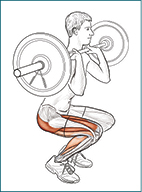
Box Surge
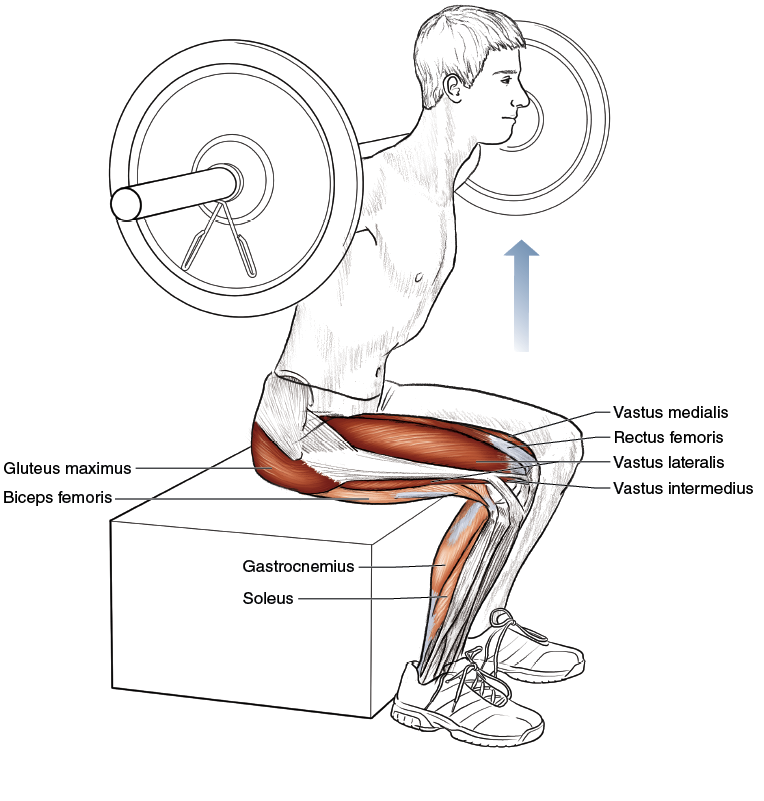

Safety Tip
Once you sit on the box, you should use a smooth movement to stand. If you jerk or abruptly move, you may injure your back or knees.
Execution
1. Stand with your feet slightly wider than your pedal width, and place the bar across your shoulders. A box or bench should be positioned behind you.
2. Bend at the knees until you are sitting on the box. (Your knees should be bent at or just above 90 degrees when you are sitting on the box.) Disengage your leg muscles.
3. From a “dead start,” slowly extend your knees and return to the standing position.
Muscles Involved
Primary: Gluteus maximus, quadriceps
Secondary: Erector spinae, hamstrings, gastrocnemius, soleus, hip adductors
Cycling Focus
This exercise helps develop raw, explosive power that will give you a strong starting snap in your pedaling downstroke—the kind of power suited to attacking a climb or covering a sudden fast break by another rider. Imagine the end of a bike race when it’s just you and one other rider. The one who can get the strongest “jump” at the appropriate time will raise his arms in victory at the line. This exercise disengages your muscles while sitting on the box so you can develop maximum power at your weakest point. You must sit fully on your buttocks and relax your leg muscles. You want to lift the weight from a dead rest. This will remove the “spring” or “rebound” advantage of the traditional squat.

Variation
Box surge on stability disks: For an extremely difficult exercise, try standing on stability disks while surging from the box. This exercise takes practice and balance, so start with a low weight and work your way up!
Split-Leg Squat
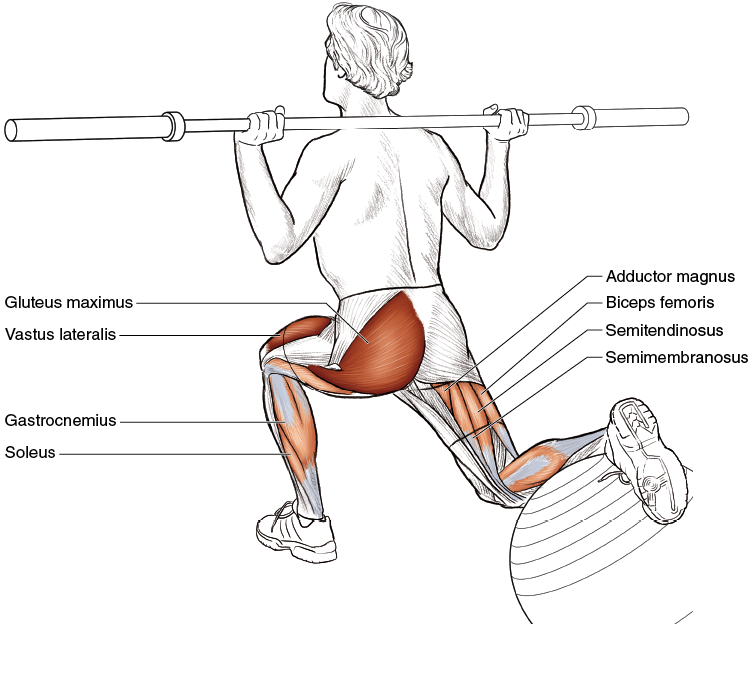
Execution
1. While standing, place a barbell over your shoulders.
2. Place one foot slightly forward. Extend your other leg back, placing your foot on top of a stability ball.
3. Slowly bend your front knee until it makes a 90-degree angle. Return to the standing position.
Muscles Involved
Primary: Gluteus maximus, quadriceps
Secondary: Erector spinae, hamstrings, gastrocnemius, soleus, hip adductors
Cycling Focus
Imagine climbing up a steep grade and having to accelerate to match an attack from another rider. You’ll need to maximize your entire pedal stroke to meet the challenge. Split-leg squats will help you develop powerful quadriceps, which will enable you to deliver a strong kick over the top of your pedal stroke. This is also an important exercise for cyclists because it lets them train each leg individually. Without knowing it, cyclists often have one leg that is disproportionately stronger than the other. This can be hidden when the cyclist is performing exercises that use both legs simultaneously. In the split-leg squat, any inequalities will be recognized and can be remedied through training.

Variations
Split-leg squat with bench: For more stability, you can place your rear foot on a bench. This will help if you are finding it difficult to keep your balance while doing the exercise with a stability ball.
Smith machine split-leg squat: The Smith machine is another more stable option. Using the Smith machine will help stabilize your movement. It will also help protect your back and provide you with an artificial spotter.
Machine Leg Press
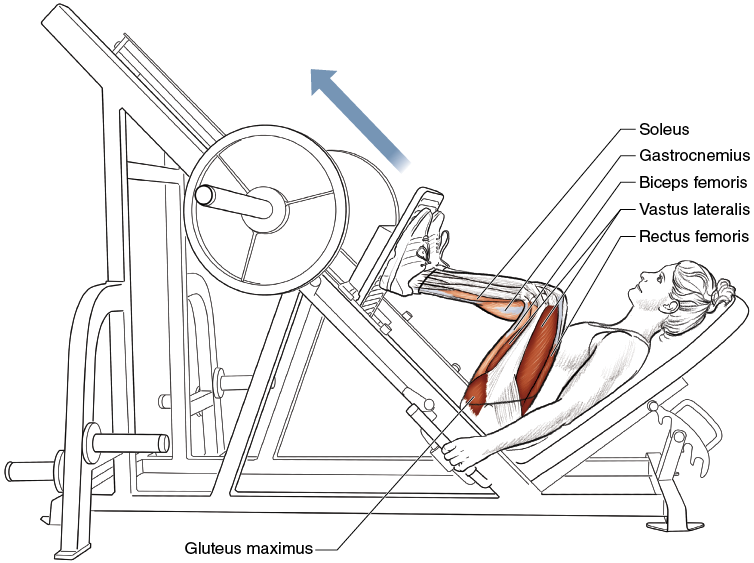
Execution
1. Sit on the sled with your feet shoulder-width apart and your back flat against the padded seat.
2. Slowly bend your knees and lower the weight until your knees are at a 90-degree angle.
3. Extend your legs and return the weight to its original position. (Don’t lock your knees.)
Muscles Involved
Primary: Gluteus maximus, quadriceps
Secondary: Erector spinae, hamstrings, gastrocnemius, soleus, hip adductors
Cycling Focus
This is a cyclist’s bread-and-butter leg exercise. The leg press machine allows you to work on your upward surge. It helps you develop explosive cycling power. Because of the solid back support provided by the machine, there is less chance that you’ll injure yourself when accelerating out of your squat position. By changing your foot position, you can emphasize different muscles of your lower extremity. Placing your feet high on the footplate will focus the training on your gluteus maximus and hamstrings. A low foot position will emphasize your quadriceps. Stance width can also be adjusted to focus your training on various muscles. A wide stance especially works your vastus medialis (inner quad), sartorius, and hip adductors. A narrow stance puts the focus on your vastus lateralis (outer quad) and hip abductors.
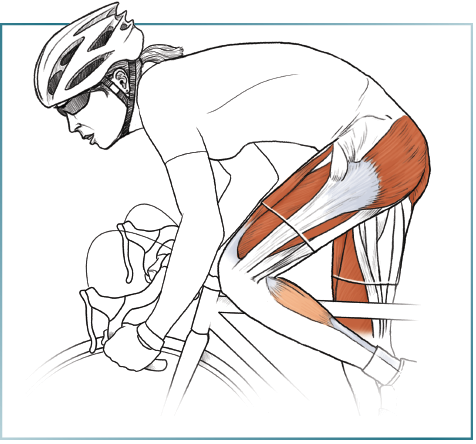
Variation
Hack squat: While standing, position your back flat against the sliding back rest. Wedge your shoulders snugly under the pads. Slowly perform a squat as described on page 148. The hack squat places added emphasis on your quadriceps. Like the leg press, you can switch between squats, calf extensions, and reverse calf raises (described in chapter 7). You can also exercise one leg at a time to ensure equal training.
Wall Stability Ball Squat

Execution
1. While standing, place the stability ball between your lower back and the wall.
2. Hold two dumbbells in your hands with your arms straight at your sides.
3. Perform a squat motion, bending your knees to 90 degrees. The ball will roll as you squat.
4. Return to the starting position.
Muscles Involved
Primary: Quadriceps, gluteus maximus
Secondary: Hamstrings, hip adductors
Cycling Focus
This exercise not only helps you develop strong pistons to drive the pedals, but also emphasizes your abdominal muscles, back muscles, and lower extremity stabilizers. Because the stability ball can roll any direction on the wall, you’ll be forced to control your foundation as you lift the weight. This instability helps strengthen your core and prepares you for the later miles of your rides. When you become tired, your form can start to fail, and your efficiency will drop. The longer you can prevent this from occurring, the better results you’ll have.

Variations
Timed squat: Position yourself as described, but don’t use the dumbbells. Rather than do repetitions, proceed to the down position and hold it for a fixed amount of time. For example, you could hold the position for 30 seconds, 1 minute, 2 minutes, or more depending on your strength and conditioning.
Squat on stability disks: For some real instability, perform the timed exercise while standing on two stability disks. This places even greater emphasis on all your accessory muscles.
Single-Leg Stability Arc

Execution
1. Place an arc of five cones in front of you, and stand with one foot on a stability disk.
2. Bend your leg and lean forward to touch one of the cones with your same-side hand.
3. Return to the standing position and repeat the movement to each of the cones.
Muscles Involved
Primary: Gluteus maximus, quadriceps
Secondary: Erector spinae, hamstrings, gastrocnemius, soleus, hip adductors, rectus abdominis, accessory stabilizers
Cycling Focus
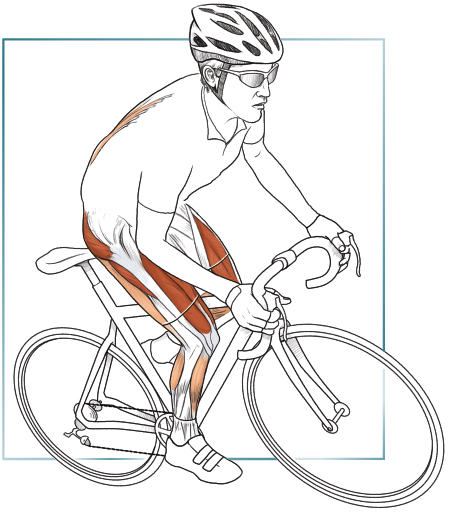
The single-leg stability arc places a large amount of strain on all the primary and accessory muscles used in cycling. This exercise may look simple at first glance, but if you do it correctly, it will be very taxing. Many professional cyclists use this exercise early in the season to help prepare them for the many miles that lie ahead. Time after time, I’ve seen athletes with mid- and late-season injuries because their foundation was not able to handle the season’s load. This exercise establishes your base. Because it is such a fundamental movement and relies so heavily on all your stabilizers, it conditions not only your muscles, but also your joints, tendons, and ligaments. During a hard ride, when fatigue is maximal, you can start to lose your pedaling form. This exercise trains you to maintain proper motion when your primary muscles (quadriceps, hamstrings, gluteals) are nearly spent.
Variations
Dumbbell stability arc: Holding a dumbbell during the exercise will increase the difficulty level and place even greater strain on your accessory muscles.
Floor stability arc: If you have trouble maintaining your balance on the stability disk, you can start with your foot on the floor and work up to using the disk over time.
Double-Leg Power Jump
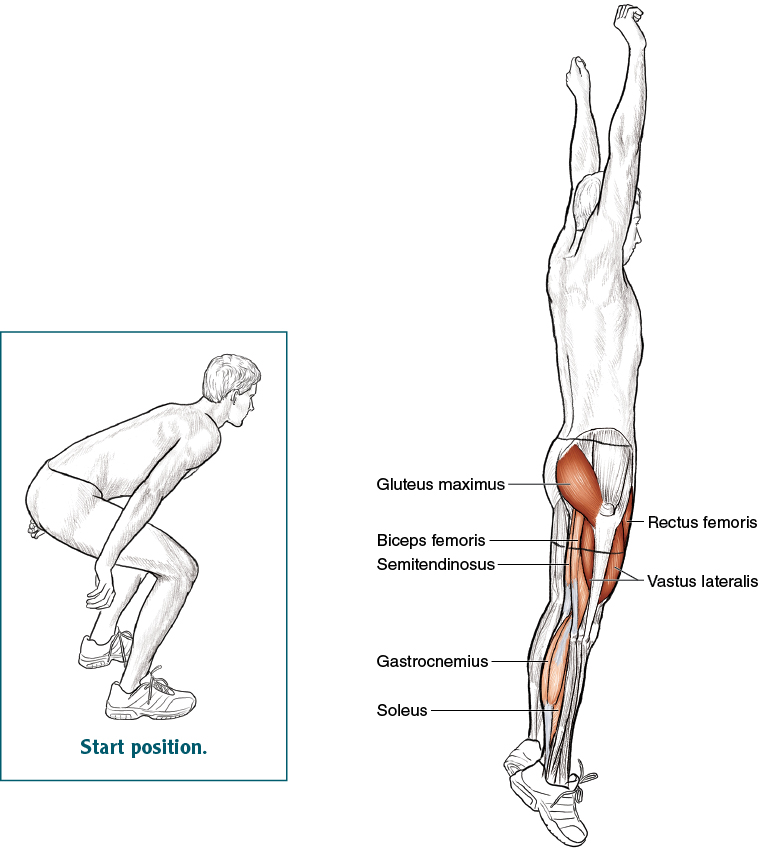
Execution
1. Stand in the squat position with your feet slightly wider than shoulder-width apart. Your knees should be at 90 degrees.
2. Aggressively throw your arms forward and upward while jumping as high and as far forward as possible.
3. Upon landing, return to the squatting position and repeat.
Muscles Involved
Primary: Gluteus maximus, quadriceps
Secondary: Erector spinae, hamstrings, gastrocnemius, soleus, hip adductors
Cycling Focus
This exercise is all about explosive cycling power. Many professional cyclists use this simple exercise to develop sudden, high-end power. The power jump helps you build the strength to sprint for the line or to break away on a climb. Think of yourself as a coiled spring, and start the exercise with an explosive burst. Be sure you don’t do this exercise when your muscles are cold (this could result in a pulled muscle). After the aggressive upward phase, you should try to land as gently as possible. This forces all your muscles to activate once again, and you get the most benefit from your training.

Variation
Single-leg jump: Perform the jump the same as the double-leg version, but keep one foot off the floor the entire time. These jumps are difficult but will further develop your explosive power.
Lunge

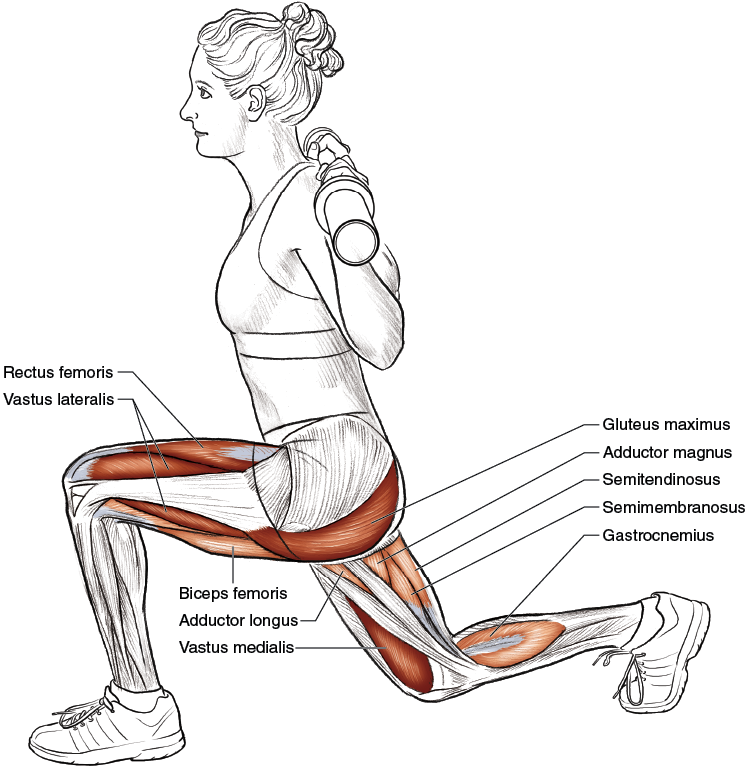
Safety Tip
Make certain to keep your head up. This helps keep your spine straight and protects your back.
Execution
1. Stand with your feet shoulder-width apart and with the barbell over your shoulders.
2. Keeping your back straight and your head up, step forward until your front knee is making a 90-degree angle and your front thigh is parallel with the floor. Your trailing knee will be slightly above the ground. To avoid injury, make sure your knee does not move forward beyond your toes.
3. Return to the starting position by stepping back with your forward foot. Repeat the exercise with your opposite leg.
Muscles Involved
Primary: Gluteus maximus, quadriceps
Secondary: Erector spinae, hamstrings, gastrocnemius, soleus, hip adductors
Cycling Focus
When you see a professional cyclist zip by in his tucked aero position during a time trial, you can see the raw power in his legs as he taps out his cadence. The lunge exercise brings you that same power. This exercise not only develops power for your downstroke, but also for your upstroke, giving you a consistent pedaling motion. Most professionals recognize the importance of this exercise and include it in their training program. You’ll definitely feel this workout the next day, so don’t overdo it in the gym. You may have a tendency to lean forward as you become more fatigued; you must focus on keeping your back straight throughout the exercise.
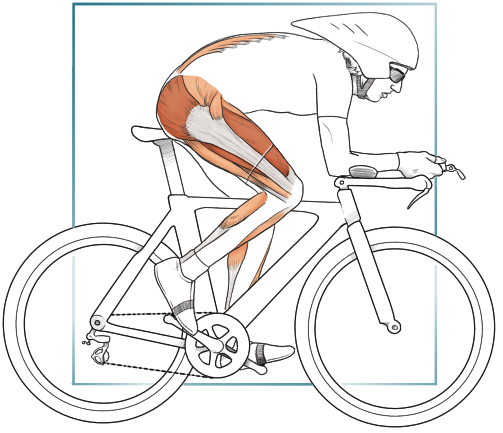
Variation
Side Lunge
The lateral lunge develops strength through your legs’ entire range of motion. By training this lateral movement, you’ll stabilize your knee joint and prevent injury.
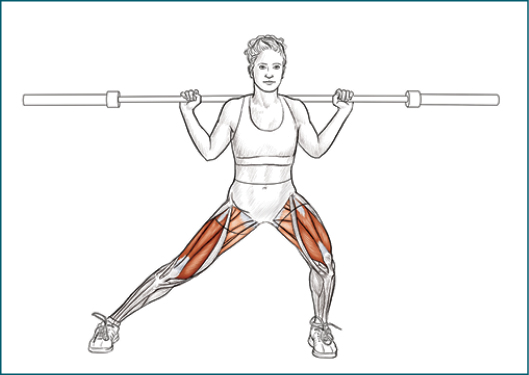
Step-Up

Execution
1. Facing a 16- to 18-inch (41 to 46 cm) box, stand with the barbell over your shoulders.
2. Step up with your left leg. Follow through with your right leg until your left leg is straight and your right thigh is parallel with the ground. (Your right leg never touches the box.)
3. Step back down with your right foot first, followed by your left foot. After you complete a set, repeat on the opposite side.
Muscles Involved
Primary: Gluteus maximus, quadriceps
Secondary: Erector spinae, hamstrings, gastrocnemius, soleus, hip adductors
Cycling Focus
Climbing ability is fundamental to every cyclist. When you work this exercise in the gym, imagine attacking the peloton on a long climb. With each dynamic step upward during the exercise, you’ll mimic your powerful pedaling downstroke. Controlling your body as you step up helps strengthen your primary force muscles and also conditions your back muscles, abdominal muscles, and accessory leg muscles. Whether you’re climbing in or out of the saddle on your bike, the extension of your gluteus maximus and quadriceps plays a major role in power transfer to the bike. By using the step-up exercise, you’ll definitely see returns in your climbing prowess.

Variation
Side Step-Up
You can perform this same exercise to the side. (You may need a slightly lower box to perform this exercise.) Standing with the box to your right, step up with your right leg while keeping your back straight. Follow through with your left leg until your left thigh is parallel with the floor. Return your left foot to the floor.
